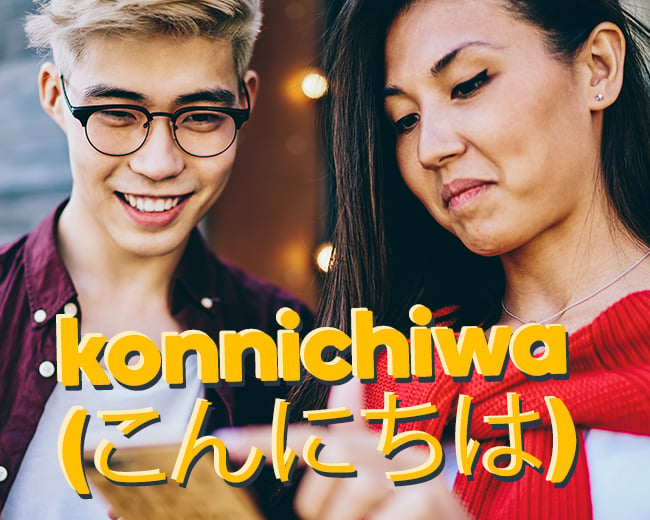Did you know that people use spoken language and body language to say hello in Japanese? Wait, WHAT!? Yep. So when making your aisatsu 挨拶 (greeting) in Japan – remember that it’s more than just a ‘hello!’ Put away that handshake. A bow is the proper way to greet people in Japan!
Fun fact: the greater angle (how far you bow down!) and duration of your bow shows the level of respect.
From serious to casual:
- 15 degrees (informal)
Best used when casually greeting someone!
- 30 degrees (friendly formal)
Best used in business situations like meeting clients
- 45 degrees (the highest form of respect)
Best used when meeting someone of very high status
Need some help? Watch this video and practice your bows!
This might seem more than you signed up for when learning Japanese, but it’s fun to try! Quick tips: pick a spot on the floor to look at because eye contact is considered rude. Also: putting your hands together is a Western stereotype! Keep them by your sides!
How to say hello and greet in different situations
So whether you’re taking a tour of beautiful Japan or attending daily business meetings – you need to know how to say hello and greet in different situations.
Saying hello in English is easy, right? But saying hello in Japanese is a whole different story because it depends highly on context. Meaning there are different ways to greet people in Japan depending on the situation you find yourself in. So before thinking ‘how do you say hi in Japanese?’ – take a minute to sum up the situation.

It’s awesome that you want to learn Japanese. You’re going to smash it! But before you show off your new language, you’ll need to start conversations the right way!
We’ve got you covered. Below teaches you how to say hello in Japanese in a bunch of different scenarios. (Check out our Japanese Video Phrasebook for more useful phrases).
How to say hello in Japanese
So how do you say hello in Japanese? These will equip you nicely in ‘The Land of The Rising Sun’:
konnichiwa (こんにちは)
Konnichiwa (こんにちは) is said between late morning (11am) and early evening (5pm) in Japan. It’s a formal kind of ‘hello!’. So you wouldn’t say konnichiwa with your best mate. Hear a Japanese local saying it below!
otsukaresama desu (お疲れ様です)
Japanese colleagues have a specific term for saying hello to each other in the workplace: otsukaresama desu (お疲れ様です). It shows recognition of mutual hard work and is best used when arriving into the office as a greeting.
If saying hello on a work call try osewa ni natte orimasu (お世話になっております) to show you appreciate the relationship. Or hai はい (hello), followed by your company name. It’s a little fancier.
moshi moshi (もしもし)
moshi moshi (もしもし) is best used on the phone as a ‘hello are you there?’ kind of saying. Save it for this only.
yā やあ, yō よう, yahhō ヤッホー
When you make some cool Japanese friends after learning Japanese with Memrise (😉), you’ll be calling on Yā = hi! Yō = yo! and yahhō = hey all the time. These are all informal and used with friends. Especially among the young generations and with lots of enthusiasm! Woo!
saikin dō? 最近どう? and dōmo どうも
Just how cool are you? Saikin dō translates to ‘what’s up?’ And dōmo can mean hi, thanks, in a friendly polite way. Both work nicely when picking up the phone to a friend. Saikin dō for getting flirty at a party... Just please PLEASE: don’t say this to your boss… or girlfriend’s parents. Okay?
Is there a difference between them?
Yep! Their use depends on time and situation! Otsukaresama desu (お疲れ様です) is used in the workplace. Konnichiwa (こんにちは) is used as a formal hello between late morning and evening. In contrast, yā (やあ), yō (よう), yahhō (ヤッホ) and saikin dō (最近どう)) are used informally to greet friends! Dōmo (どうも) is more friendly formal. Struggling to connect on the phone? Use moshi moshi もしもし as a questioning hello.
How do you say nice to meet you in Japanese?
Rumour has it when you first meet someone… you have 7 seconds to make a good first impression. 👀 This is when your ‘nice to meet you’ goes a long way!
hajimemashite はじめまして = nice to meet you
If you’ve been introduced to someone try:
yoroshiku onegaishimasu よろしくおねがいします = nice to meet you! (after introduction)
Keeping up? Good. There are more cool ways to greet people in Japanese than hello, hi and nice to meet you! Read on to greet like a real local!
How do you say good morning in Japanese?
Ahh… another beautiful Japanese morning. Time to light up people’s day with a ‘ohayō’ おはよう 🌞
Ohayō おはよう = morning! (casual)
Other ways to say good morning:
-
Ohayō gozaimasu おはようございます= good morning (formal)
-
minna, ohayō! みんな、おはよー!= good morning everyone (to friends)
-
minasan, ohayō gozaimasu 皆さん、おはようございます
= good morning everyone (formal: e.g. teacher to students)
How do you say good afternoon in Japanese?
Ok. So we mentioned earlier that konnichiwa (こんにちは) is used as a formal ‘hello!’ in Japan. But did you know it also means ‘good afternoon’!?
How do you say good evening in Japanese?
Tokyo’s evening neon lights are inviting you out for some delicious food and drink. Time for a:
Kombanwa/Konbanwa (こんばんは) = good evening
How to say welcome in Japanese?
There are a handful of different ways to say welcome in Japanese. Let’s talk you through them.
Yōkoso ようこそ = welcome
The most used ‘welcome!’ greeting in Japan. You’ll hear it when you arrive at the airport or pop over to a friend’s house!
Irasshaimase いらっしゃいませ = welcome, come in!
irasshaimase (いらっしゃいませ) is something to listen out for rather than speak. You’ll hear it when you walk into a restaurant or convenience store. It’s a welcoming kind of ‘come in’. How nice!
Okaerinasai – welcome back おかえりなさい。
Okaerinasai or okaeri おかえり (shorter version) welcomes someone’s return! It works well in response to tadaima (ただいまただいま) – which people say to announce their arrival!
How to say goodbye in Japanese?
Nothing lasts forever. So how do you to say bye in Japanese?
Like a lot of Japanese language, it depends on social context.
A common misconception is that sayonara さようなら is how to say goodbye in Japan. NOPE! Sayonara is rarely used and is actually kind of rude 🤬. It’s a hard goodbye – ‘goodbye forever! I’m not sure we’ll see each other again.’
Instead, check out these Japanese goodbyes that’ll equip you for any situation:
-
jāā ne じゃあね = see you! (informal)
-
mata ne またね = see you later/see you next time
Super easy and casual. Use them with friends and family.
More specific examples:
-
itte kimasu いってきます行って来ます = goodbye (when leaving your house)
-
osaki ni shitsureishimasu お先に失礼します = goodbye (leaving work) – meaning ‘excuse me for leaving you’.
-
o-genki de お元気で = take care/keep well (best used before someone goes away somewhere and you won’t see them in a while).
How to say goodnight in Japanese?
The night’s over. You need to finish your sake and get some sleep.
Here’s how you say goodnight in Japanese:
-
Oyasumi おやすみ = Good night (informal)
Used with family and friends.
-
Oyasumi nasai おやすみなさい = Good night (formal)
Used when saying goodnight to your guest, teacher, boss (on a business trip).
That’s it, folks! You now know how to say hello and greet people in lots of different situations and at different times. Pretty awesome, right?
Listen up. Your moment to learn Japanese is now. Keep practising little and often and you can learn this fascinating language in no time! You got this.
Tweet us @Memrise to let us know how you’re getting on!








